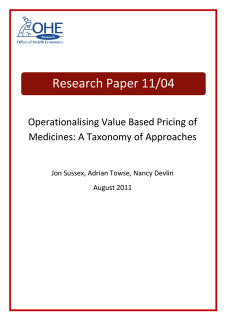Economics of Innovation
Optimal innovation balances willingness and ability to pay with the benefits of future R&D. Our wide-ranging programme aims to promote innovation in health care, increase our understanding of its value, and encourage R&D. New models of innovation should streamline development, reduce costs, and speed patient benefit.

OHE in the Spotlight: Summer 2011
22 September 2011
This is the first in a series of posts that will review OHE’s contributions to advancing thought and stimulating innovative ideas in its three key research…

Incentives for R&D for New Antimicrobial Drugs
31 August 2011
Just published by OHE researchers is a comprehensive analysis of what policy measures are needed to counter the growing global problem of antimicrobial resistance. Their key…

Recent Statistics on Orphan Approvals in Scotland and England
23 August 2011
In October 2009, the OHE published research that compared access to orphan medicinal products (OMPs) in selected European countries. At the request of the UK Orphan…

Pricing in Emerging Markets: Income, Competition and Procurement
16 August 2011
Most patients in middle and low income countries (MLICs) lack insurance coverage and so pay out of pocket for prescription medicines; pricing commensurate with income thus…

New: Operationalising Value Based Pricing
11 August 2011
To date, the UK Government has not been specific about how VBP will be implemented, but has indicated that calculations of value will extend beyond the…

Previews of Forthcoming Publications
27 July 2011
OHE is making available as Occasional Papers drafts of two important chapters that will appear in the Oxford Handbook on the Economics of the Pharmaceutical Industry…

News Release: Fighting Superbugs
6 July 2011
A new report today by the Office of Health Economics (OHE) called for a shake up in the way future antibiotics are to be rewarded in…

Drugs and Vaccines for Developing Countries
1 June 2011
Forthcoming in the Oxford Handbook on the Economics of the Biopharmaceutical Industry, this paper describes the context of the problem of access to medicines in developing…

Measuring Value with Pharmacoeconomics
26 May 2011
In forthcoming chapter in the Oxford Handbook on the Economics of the Biopharmaceutical Industry, experts in the field outline the evolution of cost-effectiveness analysis (CEA) through…